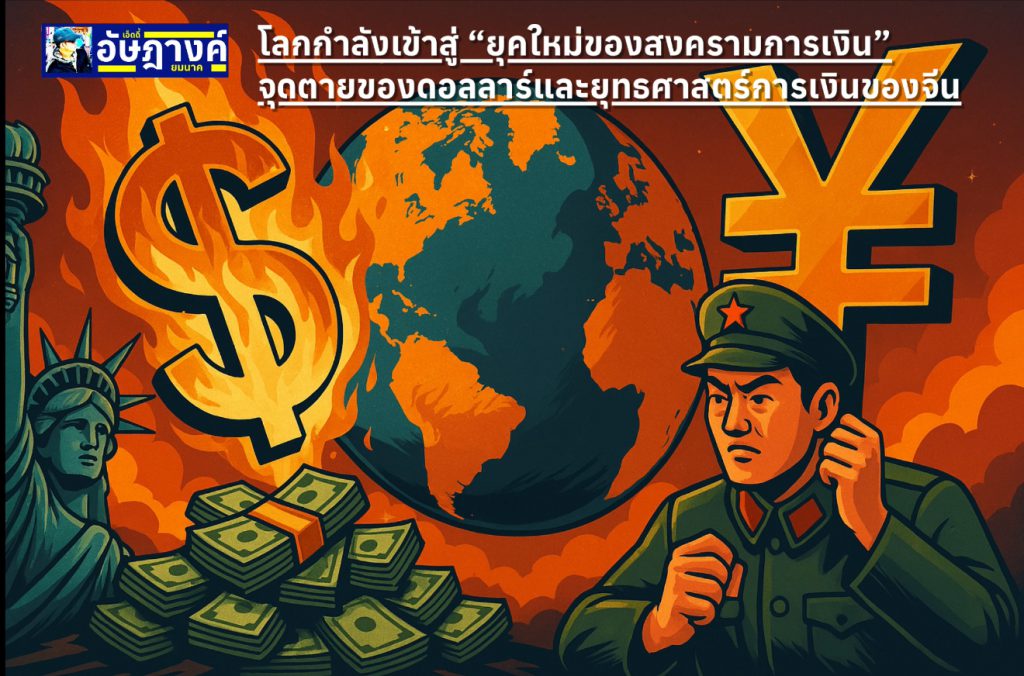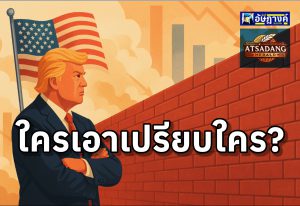
โลกอาจจะกำลังเข้าสู่ “สงครามการเงินยุคใหม่”
โดย อัษฎางค์ ยมนาค
_______________________________________________
1. บริบทโลก: จุดตายของดอลลาร์และยุทธศาสตร์การเงินของจีน
ในขณะที่สหรัฐอเมริกายังคงใช้ นโยบายดอกเบี้ยสูงเพื่อควบคุมเงินเฟ้อ (สูงกว่า 5% ต่อเนื่อง) เศรษฐกิจในประเทศกลับเริ่มแสดงสัญญาณชะลอตัวจากภาวะต้นทุนทางการเงินที่สูงจนกลายเป็นแรงกดดันต่อการลงทุนและการบริโภค
ในเวลาเดียวกัน จีนในฐานะผู้ถือครองพันธบัตรสหรัฐรายใหญ่ ได้ทยอยลดการถือครองพันธบัตรลงมาเหลือประมาณ 7.7 แสนล้านดอลลาร์ (ต่ำสุดในรอบกว่า 15 ปี) โดยมีกลยุทธ์ที่ชัดเจนคือ:
• “ริน” พันธบัตรออกทีละน้อย เพื่อไม่ให้ตลาดผันผวนรุนแรง แต่สร้างแรงกดดันให้ yield ขึ้นเรื่อย ๆ
• นำเงินที่ได้ เปลี่ยนสัดส่วน asset allocation ไปสู่ทองคำและสินทรัพย์ที่ไม่อิงดอลลาร์
• ปรับกลยุทธ์ FX Reserve เพื่อ ประคองค่าเงินหยวน และหลีกเลี่ยงการพึ่งพาดอลลาร์
นี่ไม่ใช่เพียงกลยุทธ์ทางการเงิน แต่คือ ยุทธศาสตร์ทางภูมิรัฐศาสตร์ ที่ออกแบบมาเพื่อลดอำนาจดอลลาร์สหรัฐในระบบเศรษฐกิจโลกอย่างเป็นระบบ
_______________________________________________
2. Bond Yield และ “กับดักหนี้สาธารณะ” ของอเมริกา
การที่ bond yield ของสหรัฐ โดยเฉพาะพันธบัตรระยะยาว (เช่น 10-Year Treasury Yield) ปรับตัวสูงขึ้นติดต่อกัน บ่งชี้ว่า:
• นักลงทุนต้องการผลตอบแทนมากขึ้นเพื่อชดเชยความเสี่ยง
• ความสามารถในการออกพันธบัตรใหม่ (rollover) เริ่มถูกตั้งคำถาม
• ภาระดอกเบี้ยที่ต้องจ่ายเริ่มกินงบประมาณของรัฐบาลกลางอย่างหนัก (ปี 2025 ดอกเบี้ยจ่ายสูงเกิน 1 ล้านล้านดอลลาร์ต่อปี)
กล่าวได้ว่า เศรษฐกิจอเมริกากำลังเข้าสู่ “กับดักดอกเบี้ยสูง” ที่ไม่สามารถลดดอกเบี้ยได้ แม้เศรษฐกิจเริ่มชะลอ เพราะจะยิ่งกดค่าเงินดอลลาร์ และเสี่ยงต่อการเกิดวิกฤตความเชื่อมั่นในพันธบัตรรัฐบาล
_______________________________________________
3. โลกกำลังเข้าสู่ “ยุคใหม่ของสงครามการเงิน” (Currency & Bond War)
ตลาดการเงินโลกถูกครอบงำโดย 3 กลไกหลัก:
1. ตลาดหุ้น (Equity Market) – ผู้เล่นทั่วไป เข้าถึงได้ง่าย แต่มีขนาดเล็ก
2. ตลาดพันธบัตร (Bond Market) – เป็น “หัวใจของระบบการเงินโลก” ที่สะท้อนต้นทุนเงิน และความเสี่ยงของประเทศ
3. ตลาดอัตราแลกเปลี่ยน (FX Market) – ใหญ่ที่สุดในโลก ซื้อขาย 24 ชม. และสะท้อนความเชื่อมั่นต่อเศรษฐกิจแต่ละประเทศ
เมื่อพันธบัตรกลายเป็นสนามรบหลัก การเคลื่อนไหวของ yield, การถือครองพันธบัตร และท่าทีของธนาคารกลางทั่วโลก จึงเป็นสัญญาณที่ต้องจับตาอย่างใกล้ชิด
_______________________________________________
4. ผลกระทบต่อประเทศไทย: มากกว่าค่าเงินบาทผันผวน
สถานการณ์นี้ส่งแรงกระแทกสู่เศรษฐกิจไทยในหลายมิติ ดังนี้:
1. ความผันผวนของค่าเงินบาท
• หากนักลงทุนต่างชาติเทขายพันธบัตรไทย หรือดึงเงินกลับสหรัฐ จะทำให้เงินบาท อ่อนค่ารวดเร็ว
• เงินบาทอ่อน ส่งผลให้ ราคานำเข้า เช่น น้ำมัน พลังงาน และอาหารแปรรูปแพงขึ้น → ดันเงินเฟ้อในประเทศ
2. ความเสี่ยงด้านดอกเบี้ย
• หากไทยต้องพึ่งพาการออกพันธบัตรในประเทศ (เพื่อชดเชยงบประมาณขาดดุล) ต้นทุนดอกเบี้ยของรัฐอาจสูงขึ้น
• ภาคธุรกิจ โดยเฉพาะ SMEs ที่มีภาระหนี้ อาจได้รับผลกระทบจาก ต้นทุนทางการเงินที่สูงต่อเนื่อง
3. ตลาดการส่งออกและการลงทุน
• หากเศรษฐกิจสหรัฐเข้าสู่ภาวะถดถอย นักลงทุนจะลดการลงทุนในประเทศคู่ค้า รวมถึงไทย
• การส่งออกของไทยไปยังสหรัฐ (มูลค่ารวมกว่า 1.4 ล้านล้านบาทต่อปี) จะถูกกระทบโดยตรง
_______________________________________________
5. ข้อเสนอเชิงยุทธศาสตร์สำหรับไทย
1. จัดตั้ง Economic War Room ระดับนโยบาย
• รวมผู้กำหนดนโยบายการเงิน การคลัง การค้าระหว่างประเทศ และ BOI
• ติดตามสถานการณ์ “Bond Market” และ “FX Volatility” อย่างใกล้ชิด พร้อมมีมาตรการรับมือแบบ real-time
2. เร่ง reposition ประเทศเป็น “Tech-enabled Manufacturing Hub”
• ดึงดูดโรงงานและ supply chain ที่ย้ายออกจากจีน
• ใช้โอกาสนี้เสนอแพ็คเกจจูงใจนักลงทุน (ภาษี–ที่ดิน–โลจิสติกส์–ทักษะแรงงาน)
3. ใช้ Nation Branding เป็นเกราะทางเศรษฐกิจ
• สร้างภาพลักษณ์ไทยในฐานะ “พันธมิตรการค้าโปร่งใส” และ “ประเทศที่เคารพกติกาสากล” เพื่อลดโอกาสถูกขึ้นภาษีจากสหรัฐ
• เสริมความมั่นคงทางเศรษฐกิจด้วย Brand Management ระดับประเทศ
4. ปฏิรูปโครงสร้างทางการคลังและการลงทุน
• ลดการพึ่งพาหนี้ระยะยาว
• เพิ่มการลงทุนในโครงสร้างเศรษฐกิจใหม่ เช่น AI, Green Energy, Logistics, Biotechnology
_______________________________________________
สรุป: ไทยต้อง “ตื่นทันเกม” ก่อนคลื่นลูกใหญ่จะถึงฝั่ง
สงครามการค้าอาจจบลงด้วยการเจรจา
แต่สงครามการเงิน—โดยเฉพาะในตลาดพันธบัตร—กำลังกลายเป็นสนามรบที่มองไม่เห็น
หากประเทศไทยยังไม่ปรับยุทธศาสตร์ทันเวลา
เราจะไม่ได้รับโอกาสใหม่จากการเปลี่ยนแปลงของเศรษฐกิจโลก แต่จะถูกแรงสั่นสะเทือนลูกใหญ่จากดอลลาร์ถล่มกลับมาหาเราแทน
นี่จึงเป็นช่วงเวลาที่ประเทศไทยต้อง “กล้าคิดใหม่–กล้าเดินเกมใหม่” เพื่อความมั่นคงทางเศรษฐกิจระยะยาว
_______________________________________________
Exclusive Analysis:
The Bond War, Global Economic Restructuring, and Thailand’s Strategic Challenge
By Atsadang Yomnak
1. Global Context: The Crumbling Dominance of the Dollar and China’s Financial Strategy
While the United States continues to enforce a high-interest rate policy (above 5%) to combat inflation, its domestic economy is beginning to show signs of deceleration. The burden of borrowing costs has begun to weigh heavily on both consumption and investment.
Simultaneously, China—one of the largest foreign holders of U.S. Treasuries—has been steadily reducing its holdings, now down to approximately USD 770 billion, the lowest in over 15 years. This move reflects a calculated and deliberate financial strategy:
• Gradually “dripping” Treasuries into the market to avoid panic, but exerting upward pressure on yields.
• Redirecting capital flows through asset reallocation, primarily into gold and non-dollar-denominated assets.
• Adjusting its FX reserve strategy to support the yuan and reduce dependence on the U.S. dollar.
This is not merely a financial maneuver, but a geostrategic policy shift, aimed at systematically weakening the U.S. dollar’s dominance in the global economic architecture.
_______________________________________________
2. Bond Yields and America’s “Public Debt Trap”
The persistent rise in U.S. Treasury yields—especially long-term instruments such as the 10-Year note—signals deeper structural concerns:
• Investors are demanding higher returns to compensate for rising risks.
• The sustainability of U.S. debt rollovers is being questioned.
• Interest payments are ballooning, with projections exceeding USD 1 trillion annually by 2025, now rivaling defense expenditures.
In short, the U.S. economy is caught in a “high-interest-rate trap”—unable to lower rates without triggering a dollar collapse and a potential loss of investor confidence in sovereign bonds.
_______________________________________________
3. The World Is Entering a “New Era of Financial Warfare”
Global finance is dominated by three interlocking markets:
1. Equities – Familiar and accessible, but relatively small in scale.
2. Bonds – The heartbeat of global finance, reflecting capital costs and sovereign credit risk.
3. Foreign Exchange (FX) – The largest and most liquid market, operating 24/7 and directly linked to macroeconomic trust.
As sovereign bonds become the new battlefield, the movements of yields, central bank decisions, and sovereign asset allocations must now be analyzed not just economically—but strategically.
_______________________________________________
4. Implications for Thailand: Beyond Exchange Rate Volatility
This global financial shift will send ripple effects through Thailand’s economy in several key areas:
1. Currency Volatility
• A mass sell-off of Thai bonds or capital outflow toward the U.S. could trigger sharp depreciation of the baht.
• A weaker baht inflates the price of imported goods—particularly energy and food inputs, fueling domestic inflation.
2. Interest Rate Risk
• With ongoing fiscal deficits, Thailand may need to issue more domestic bonds, raising interest costs for the government.
• SMEs with high debt burdens will suffer under sustained high borrowing costs, undermining business continuity.
3. Trade and Investment Exposure
• A U.S. recession would inevitably lead to reduced FDI flows and lower U.S. import demand—affecting Thailand’s exports, which exceed THB 1.4 trillion annually to the U.S. alone.
_______________________________________________
5. Strategic Recommendations for Thailand
1. Establish a National Economic War Room
• Bring together policymakers in finance, commerce, BOI, and central banking.
• Monitor bond and FX markets in real time and develop responsive, coordinated policies.
2. Reposition Thailand as a “Tech-Enabled Manufacturing Hub”
• Attract global firms shifting supply chains out of China.
• Offer strategic incentive packages (tax, land, logistics, workforce training) to anchor value-added production in Thailand.
3. Deploy Nation Branding as Economic Defense
• Reframe Thailand’s global image as a transparent, rule-abiding, and ethical trade partner.
• Use brand management to reduce tariff risks and elevate Thailand’s trust premium in trade negotiations.
4. Reform Fiscal and Investment Structures
• Reduce reliance on long-term debt financing.
• Prioritize investment in future-focused sectors: AI, Green Energy, Advanced Logistics, Biotechnology.
_______________________________________________
Conclusion: Thailand Must “Awaken to the Game” Before the Next Shock Wave Strikes
While trade wars may be settled through negotiation, financial wars—particularly in the bond market—are invisible, relentless, and systemic.
If Thailand fails to reposition itself in time, it risks not only missing the next wave of opportunity but also becoming collateral damage in a reshaping global order.
This is a critical moment when Thailand must rethink its assumptions, reimagine its economy, and redeploy its national strategies for long-term resilience and global relevance.
_______________________________________________



